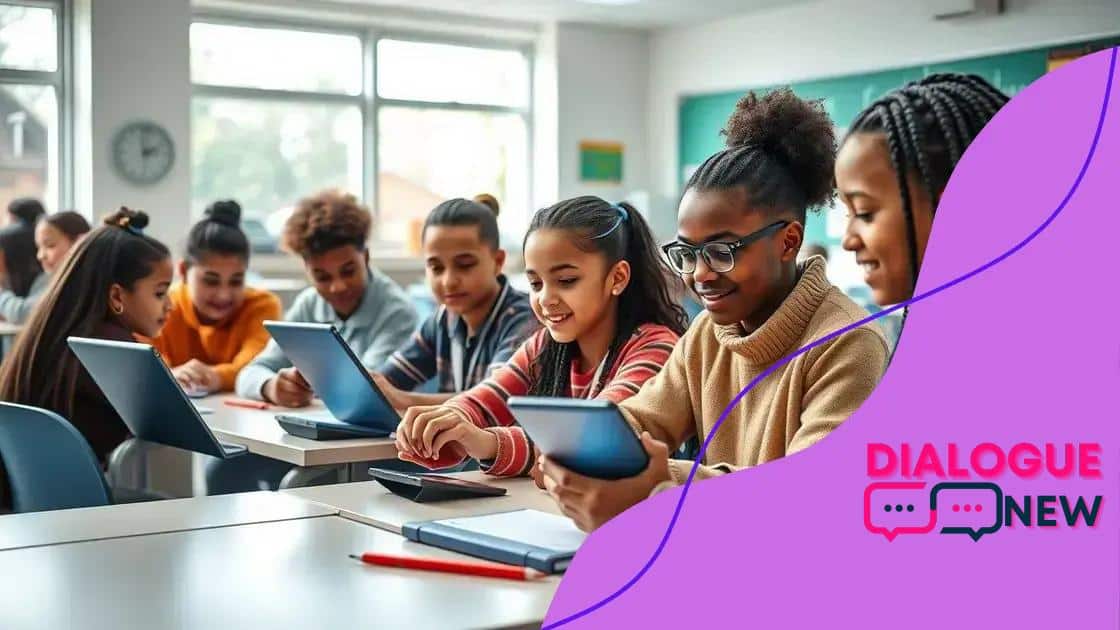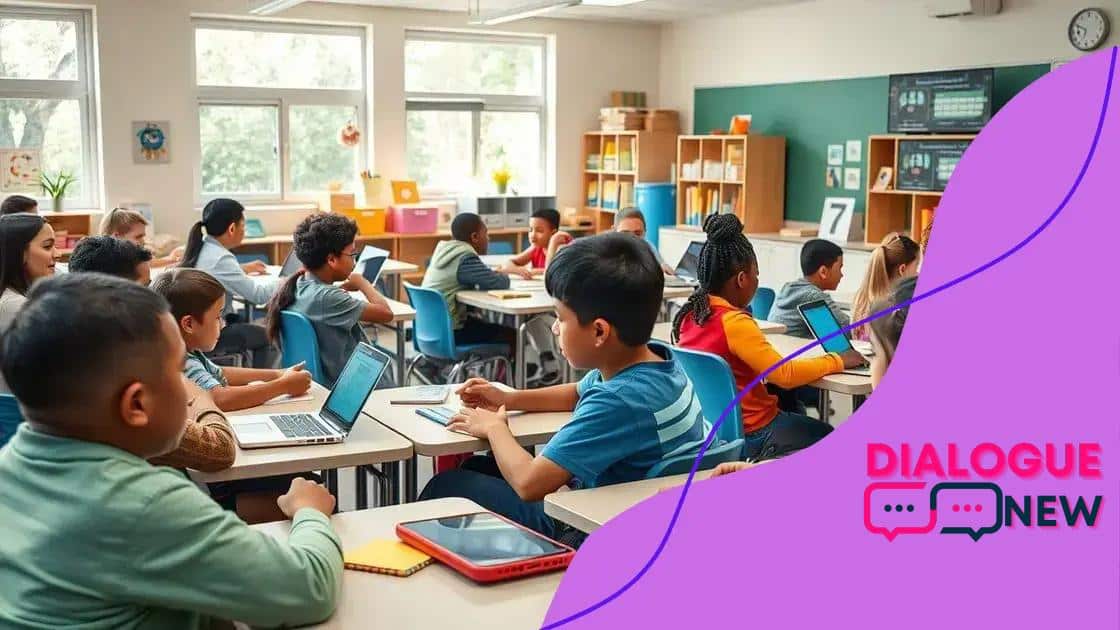AI tools for enhancing special education

AI tools for enhancing special education provide personalized learning, improved communication, and support for social-emotional skills, making education more inclusive and effective for students with disabilities.
AI tools for enhancing special education are shaping the future of learning. These innovative technologies offer personalized strategies that cater to diverse needs, making education more inclusive. Have you considered how these tools could change the way students engage with learning materials?
Understanding the role of AI in special education
AI plays a crucial role in special education by offering support that meets individual learning needs. With the help of technology, teachers can create tailored experiences that enhance learning for all students.
Key Functions of AI in Special Education
There are several key functions of AI tools that directly support students with disabilities. They help in personalizing learning, providing real-time feedback, and improving communication between educators and students.
- Personalized learning experiences that adapt to students’ unique needs
- Tools that offer real-time feedback during learning activities
- Enhanced communication aids for students with speech difficulties
Additionally, AI solutions can assist in identifying the strengths and weaknesses of students. This can lead to more precise interventions and educational strategies. Some AI applications analyze student performance data to generate insights that help teachers adjust their teaching methods.
Examples of AI Tools
Various AI tools are designed specifically for the special education sector. For example, tools like speech recognition software allow students to express their thoughts without typing. Other tools provide text-to-speech features that help those who struggle with reading.
- Speech recognition software for easy communication
- Text-to-speech programs that read content aloud
- Assistive technologies for writing
By utilizing these advanced tools, educators create a more engaging and interactive environment. This not only fosters better learning outcomes but also encourages students to participate more actively in their education.
Key AI tools and their features
There are many AI tools designed to enhance learning experiences in special education. These tools focus on different aspects such as communication, organization, and personalized learning. Understanding their features helps educators choose the right tools for their students.
Popular AI Tools in Special Education
Among the most effective AI tools, we find applications that serve specific needs. These tools can help students who need extra support, making learning more accessible for everyone.
- Speech-to-text programs: These tools convert spoken words into written text, which is helpful for students with writing difficulties.
- Text-to-speech software: This technology reads text aloud, assisting students who struggle with reading.
- Learning analytics tools: They analyze student performance and provide insights, helping teachers identify areas that need improvement.
In addition to these tools, there are platforms designed for social interaction, enhancing communication skills for students with autism. Engaging with peers is crucial for development and learning.
Features Enhancing Learning
Each AI tool comes with unique features aimed at making learning more effective. For example, many applications offer customization options that let users tailor lessons to fit individual needs. This personalization is essential in special education.
- Real-time feedback allows students to understand their progress immediately.
- Interactive interfaces encourage engagement and participation.
- Gamification elements make learning fun and rewarding.
As we look at the future of education, these AI tools will continue to evolve. This evolution will result in even more innovative features that help create inclusive learning environments.
Benefits of AI for students with disabilities

The benefits of AI for students with disabilities are significant and transformative. By incorporating artificial intelligence, educators can create more inclusive learning environments that cater to diverse needs. This technology allows for personalized learning experiences that can boost student engagement and improve outcomes.
Individualized Learning Paths
AI tools can develop individualized learning paths tailored to each student’s strengths and weaknesses. This feature helps teachers provide targeted support where it is needed most. When students receive personalized feedback and resources, they are more likely to succeed.
- Adaptive learning systems: These systems adjust content and difficulty based on student performance.
- Customized lesson plans: Teachers can create lessons that align with each student’s abilities and needs.
- Progress tracking: AI monitors learning progress and provides insights for educators.
While using these tools, students are empowered to learn at their own pace. This autonomy fosters confidence and encourages them to take an active role in their education.
Enhanced Communication
For many students with disabilities, communication can be a challenge. AI technology can bridge this gap by providing innovative solutions that improve interaction. For instance, speech recognition software allows students to express their ideas verbally instead of relying on written words.
- Augmentative and alternative communication (AAC): Tools that help non-verbal students communicate effectively.
- Real-time translation: Breaking down language barriers for students who are learning English as a second language.
- Interactive chatbots: These can provide immediate responses and support for learners.
This technological support not only enhances communication but also leads to better social connections among peers. As students engage with one another, they develop essential social skills that are crucial for their growth.
Implementing AI tools effectively in classrooms
Implementing AI tools effectively in classrooms is crucial for maximizing their benefits. With the right approach, educators can create more engaging and productive learning environments. This process includes selecting suitable tools, training teachers, and continually assessing the implementation.
Selecting the Right Tools
Choosing the right AI tools for your classroom starts with understanding the needs of your students. Different tools serve different purposes, so it’s important to match the tool with the specific challenges students face.
- Identify students’ needs: Conduct assessments to understand learning gaps.
- Research available tools: Explore options that specifically cater to special education.
- Consider user-friendliness: Ensure the tools are easy for both teachers and students to use.
This careful selection can lead to more effective use and better outcomes for students.
Training and Support for Educators
Once the tools are selected, proper training is essential. Educators must be comfortable with using AI technologies to reap their full benefits. Providing ongoing training and support can make a significant difference.
- Workshops: Conduct workshops to introduce teachers to the tools and their features.
- Peer mentoring: Encourage experienced teachers to support their colleagues in using new technologies.
- Access to resources: Supply guides and online tutorials for additional help.
As teachers become more proficient with AI tools, they will feel more confident in incorporating them into their lessons.
Ongoing Assessment and Feedback
To ensure that AI tools are being used effectively, ongoing assessment is needed. This involves gathering feedback from both teachers and students, as well as monitoring student progress. By evaluating the impact of these tools, educators can make necessary adjustments.
- Conduct surveys: Regularly ask for feedback from students and teachers about the tools’ effectiveness.
- Analyze performance data: Look at student progress to determine if the tools are meeting educational goals.
- Make adjustments: Be ready to refine tool usage based on feedback and results.
Through careful implementation, training, and assessment, AI tools can greatly enhance classroom learning experiences for all students.
Future trends in AI for special education
The future trends in AI for special education are exciting and full of potential. As technology continues to advance, it will further transform the educational landscape for students with disabilities. Educators and developers are constantly creating innovative solutions that aim to improve learning experiences.
Integration of Adaptive Learning Technologies
One significant trend is the increase in adaptive learning technologies. These tools adjust content and teaching methods based on individual student performance. This enables personalized learning that caters to each student’s specific needs.
- Data-driven insights: AI will provide better analytics on student performance, allowing teachers to refine their approaches.
- Flexible learning paths: Students will have the ability to navigate their lessons at their own pace, enhancing engagement.
- Continuous improvement: Adaptive systems will learn from each interaction, becoming more effective over time.
This technology is set to revolutionize how lessons are tailored, making education more inclusive and effective.
Enhanced Communication Tools
Another trend is the development of enhanced communication tools designed specifically for students with speech and language challenges. These tools utilize natural language processing to improve interaction and comprehension.
- Smart speech recognition: Software that helps students with speech disabilities articulate their thoughts.
- Interactive chatbots: These can assist students in practicing conversational skills in a safe environment.
- Real-time translation services: Bridging gaps for multilingual learners with disabilities.
These tools offer students greater autonomy in communication, fostering confidence and encouraging participation.
Focus on Social-Emotional Learning
The integration of AI into social-emotional learning (SEL) is gaining attention. AI tools can help monitor emotional well-being, prompting timely interventions. This focus on SEL can play a critical role in helping students with disabilities develop essential social skills.
- Emotion detection software: Uses AI to recognize emotional cues in students, allowing for support when needed.
- Social skills training applications: Programs that help students practice interpersonal skills through engaging scenarios.
- Supportive learning environments: AI can help create safe spaces for students to thrive.
As we look forward, the emphasis on SEL will create a more holistic approach to education for students with disabilities.
FAQ – Frequently Asked Questions about AI in Special Education
How can AI tools enhance learning experiences for students with disabilities?
AI tools provide personalized learning paths, allowing educators to tailor lessons to each student’s unique needs and abilities.
What types of AI tools are available for communication support?
There are various tools like speech recognition software, text-to-speech applications, and interactive chatbots that help improve communication for students with disabilities.
How does AI support social-emotional learning in special education?
AI tools can monitor emotional well-being and facilitate social skills training, creating a more supportive environment for students.
What is the importance of training teachers on AI tools?
Training ensures that educators are comfortable and competent in using AI tools effectively, which maximizes the benefits for their students.





